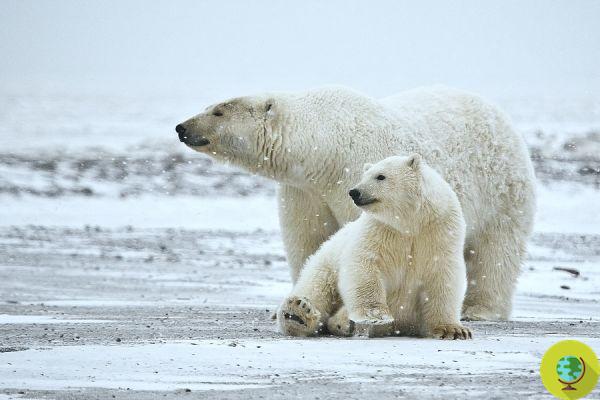
Polar bears increasingly at risk in Alaska due to climate change. Experts also point out that there are many things we don't know about the other 18 polar bear populations found in the United States, Canada, Russia, Greenland, Norway and Denmark.
He is about to end up run over, his mother saves him
- polar bears they are one of the animal species destined to disappear if measures are not taken quickly to stem the phenomenon of climate change. A recent study on the populations of these large predators carried out on those living in Alaska speaks for itself: the specimens have reduced by 40% in the space of 10 years.
According to research conducted by the Ecological Society of America (ESA) and published in the journal Ecological Applications, living bears in the south of the Beaufort Sea, they were 1500 in 2001 and in 2010 they had already reduced to 900 specimens. A worrying figure, but what is known about those predators that live in other areas of the world?
As scientists point out, there are many things we don't know about others 18 polar bear populations found in United Statesin Canada, Russia, Greenland, Norway and Denmark. For example, nine groups, living in places like northern Siberia, they are little studied because they are in awkward positions to be monitored and, above all, there is a lack of funding.
Of the most studied populations, as reported by National Geographic, four (including that of the Beaufort Sea) are in decline, five are stable, and only one, in North-Central Canada (M'Clintock Channel), is increasing.
Therefore, there is a tendency the species is decreasing but the variability of the numbers depends on the different "locations" where polar bears reside. As David Koons who studies the populations of these predators for Utah State University explained:
"If you are in the high Arctic, there is a greater chance of population stability [because] there is more ice and availability of prey."
The situation is different in the areas further south, such as the Beaufort Sea, which they are heating up quickly and consequently there is a more rapid melting of sea ice. This is why the effects on polar bears are more evident in these places than elsewhere.
It therefore appears that there is no improvement compared to what was already predicted in 2007 by the US Geological Survey which estimated that the world's polar bear population will shrink to a third of its current size by 2050, due to the loss of habitat and a scarce availability of prey.
For their part, bears seem to defend themselves as best they can arriving on the mainland and modifying one's diet by settling for snow goose and caribou eggs. However, experts argue that this will not be enough as these large predators need foods that are high in fat and higher energy density.
Read also:
Polar bears: the attempt to ban their trade has failed


























